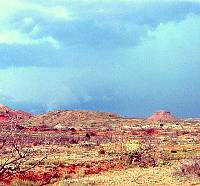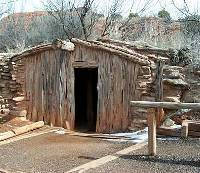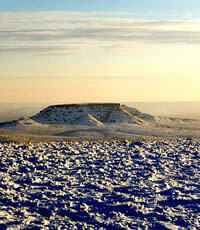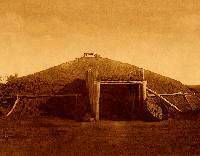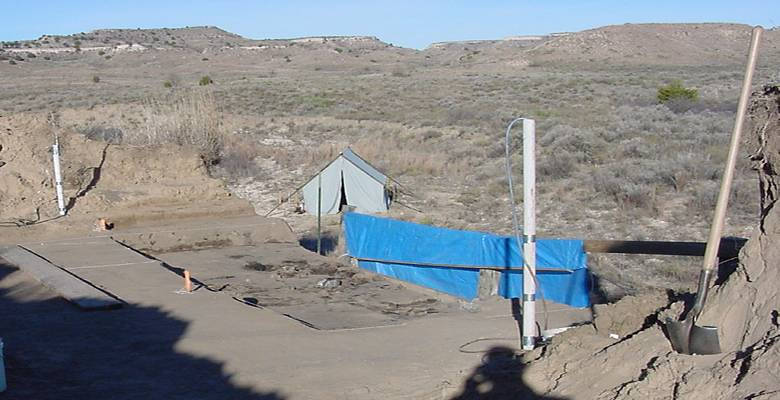
|
|
|||||
|
Anyone who has ever lived in the Texas Panhandle knows that the weather there can be harsh … even downright nasty. Springtime is plagued by constant winds, sometimes blowing 40 to 50 miles per hour, and severe thunderstorms spawning tornados and hail. This is followed by a hot summer that may have day after day of temperatures more than 100 degrees Farenheit. The fall is generally mild, but winter can be especially bad. During a severe winter storm, temperatures can drop below 0 degrees for days on end, and snow accumulations of 8 to 10 inches can blow into drifts that are several feet thick. The Panhandle town of Tulia shares the record for coldest temperature ever recorded in Texas; a bone-chilling 23 degrees below zero! No matter how you look at it, the typical weather in the Texas Panhandle and throughout the Great Plains is volatile and unpredictable. Prehistoric peoples who lived in the Southern Plains faced these same conditions without many of the modern conveniences we enjoy. We have mass-manufactured clothing and houses insulated with space-age materials, along with central heating and cooling provided by electricity or natural gas. Prehistoric peoples adapted to the severe weather conditions by making use of the natural resources and the "primitive" technology that they had. To cope with the worst winter weather, for example, their choice of clothing, where they would live, and the type of house they lived in were each important. The choices they made could mean the difference between life and death. Prehistoric people on the Great Plains made warm clothes out of the hides of animals they hunted, and buffalo hides made especially warm winter robes and blankets. Their winter villages, in deeply entrenched stream valleys that were better protected than the flat plains, had good water, lots of wood for fuel in the fireplace, and an abundance of plant and animal foods. Perhaps the most important choice that prehistoric people made to cope with the cold winters was the type of house they built. Many animals on the plains, such as prairie dogs, survive by burrowing into the ground. Many prehistoric peoples across the Southern Plains, especially those who were farmers, did the same thing and built houses that were dug into the ground. When archeologists find and dig these dwellings, we call them pithouses. The name is especially appropriate because the first stage of building such a house was, quite literally, to dig a pit. A frame made of wood logs and branches would be built, and then the earth dug out of the pit was often used to make the roof. Another variation on this theme was the earth lodge, which was dug only slightly into the ground but built up to form an earthen dome. Pithouses and earth lodges were very well suited for the plains environment. These types of dwellings take advantage of the natural insulation provided by the earth. Early pioneers in the Texas Panhandle built dugouts that were very similar to prehistoric pithouses. Even today, some residents of the Panhandle build underground homes because they are energy efficient and protect people from severe weather better than any above-ground dwelling. This exhibit tells the story about one particular prehistoric pithouse—affectionately named Hank's house—that was found in Roberts County of the Texas Panhandle, about 160 miles northeast of Amarillo. The site is on the M-Cross Ranch, owned by rancher and writer John R. Erickson and his wife Kris. John has written many books, but is famous for his more than 40 books in the Hank the Cowdog series. After discovering a buried pithouse eroding out of the cutbank of an arroyo in July, 2000, John invited a group of archeologists to help him excavate the ruins of this prehistoric dwelling in 2000 and 2001. They found that this particular pithouse had burned and that its architectural details were beautifully preserved. This exhibit answers a series of questions relating to Hank's house including: How was Hank's house found and excavated? What did it look like? How was the house built? When was the house constructed and how long was it used? Why did the house burn? The bigger question of Who were the people who lived at Hank's house? is addressed in a companion exhibit Hank's House 2: A Puzzle Wrapped in a Mystery. To read all about Hank's House we suggest you read the sections in the indicated order. To make this easy, at the end (bottom) of each section just click on: |
||||
